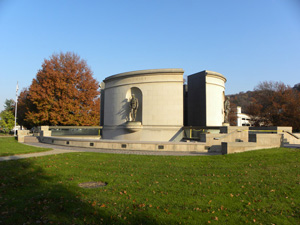

Remember...
James H. Kimbler
1915-1944
"Our obligations to our country never cease but with our lives."
 |
Remember...James H. Kimbler
|
Army Private James H. Kimbler was born in 1915 (possibly 1916), the son of Kizzie Clark Kimbler and Taylor Jackson Kimbler (also known as Jackson Taylor Kimbler). Taylor and Kizzie had at least one other child:Donna (possibly Dorothy):although due to Taylor's multiple marriages, there would likely be several half-sisters and half-brothers. The 1930 Federal Census shows Kizzie Kimbler living in Man, Logan County, West Virginia, with her two offspring, while Taylor Jackson was in Accoville, Logan County, in the household of a son-in-law.
Pvt. Kimbler enlisted in the Army at Fort Thomas, Newport, Kentucky, on August 9, 1940, nearly a year and a half before the United States entered World War II as a result of the attack on Pearl Harbor. He was originally assigned to a field artillery unit and trained at Fort Thomas. Kimbler's enlistment record shows that he had a grammar school education and was single with no dependents at the time of his enlistment. Other details of his life are sketchy, and Terry Lowry, historian for the battalion to which Kimbler was assigned for the duration of the war, has been unable to locate any living relatives who might provide information.
It is not clear when Pvt. Kimbler became attached to Company D of the 83rd Chemical Mortar Battalion, which saw action in Africa and Sicily. However, as part of this unit, he would have received further training at Edgewood Arsenal, Maryland, and Fort Gordon, Georgia. From March 12, 1942, onward, day-to-day life in the 83rd has been well chronicled in Lowry's Bastard Battalion: A History of the 83rd Chemical Mortar Battalion in WWII (Charleston, WV: 35th Star Publishing, 2009).
Mid-January 1944 found the 83rd Battalion in Sicily, heavily involved in plans for an amphibious invasion of Anzio and Nettuno, Italy. By January 22, the beaches adjacent to these two cities had been cleared.
At midnight of January 25-26, Companies C and D of the 83rd Battalion were on the LST 422, offshore Anzio. Under the direction of British LST Lt. Commander Colin Broadhurst, the naval vessel, which had been built in the U.S., but lend-leased to the British, carried not only members of the 83rd, but also sixty-five British officers and crew, twenty-three men of the 2nd Battalion of the 68th Coastal Artillery, a number of vehicles, and a great deal of ammunition.
What happened that night has been called one of the greatest naval disasters of the war. Although some accounts indicate there was an explosion not long after midnight, and it was originally thought the ship had been hit by a torpedo, the most accurate account is probably that of Broadhurst. He reported that around 5:20 a. m. the ship was blown into a minefield and struck a mine. Survivors remarked that they had noticed a sulfurous smell, which is consistent with a mine strike. By 5:25, Broadhurst had given the order to abandon ship (though this fact is sometimes disputed by those who indicated that the ship's communication system had been knocked out).
A variety of naval vessels:many of them minesweepers:began rescue efforts, and in the chaos of the rescue, LCI 32:searching for survivors:also hit a mine. While a number of men were rescued, the horrid weather conditions:wind, cold, hail, and rain:probably accounted for many of the deaths; those not killed immediately by explosions, fire, or drowning would have become subject to hypothermia. Pvt. James Kimbler would be one of the many unlucky men not rescued that night.
Lowry says: "Although it came at a high cost, and certainly not by intent, the 83rd had once again led the way in innovations, this time impacting future naval rescues" (p. 162). He points out that rescuers (and survivors) noted the inadequacy of the life belts and jackets on the LST and of the lifesaving devices. Also stressed was the importance of rapid rescue in rough and icy waters and the need for better training in first aid.
Article contributed by Patricia Richards McClure, with assistance from Terry Lowry.

West Virginia Archives and History welcomes any additional information that can be provided about these veterans, including photographs, family names, letters and other relevant personal history.